In 2006, European mobile analysts dubbed mobile the “seventh mass media channel” following print, recordings (e.g., albums, cassettes, DVDs, etc.), cinema, radio, television and the web. However, mobile failed to fulfill its promise. For mobile to have reached its true potential as a mass media channel, it needed to overcome slow and expensive carrier data networks, poorly managed carrier decks, and a heavily fragmented handset base which featured a myriad of small screens, weak processors, confusing user interfaces and clumsy WAP browsers. With so much friction in the channel, content creators were stymied in their ability to deliver compelling experiences to consumers, making mobile look far more like a niche than mass media channel.
Then, in 2007, the iPhone changed everything. In addition to unleashing a prolific media device, Apple wrested control of the storefront from carriers, convinced carriers to offer flat-rate data plans to consumers, tapped into blazing Wi-Fi as a pipe and shipped a useful mobile browser. Most importantly, they built a low-friction, robust channel through which content creators could distribute smartphone apps to consumers: the App Store.
In a few short years, with Apple as a game-changing catalyst, applications have already been downloaded tens of billions of times. Research firm, In-Stat, forecasts there will be 48 billion app downloads in 2015. With their success, apps already challenge the television in terms of reach and the Internet in terms of engagement.
For this report, Flurry used data from over 45,000 companies across their more than 85,000 applications. Flurry Analytics tracks over 15B user sessions per month across iOS, Android, BlackBerry, Windows Phone and J2ME.
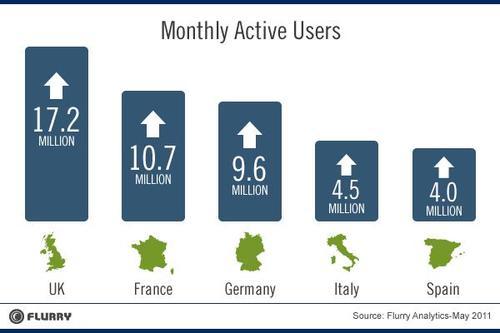
Unprecedented and Accelerating Reach
The chart above shows the number of people actively using apps on their smartphones in May 2011 across the top five European markets. Flurry calculates active smartphones by first measuring its own penetration across these devices via apps into which Flurry Analytics has been integrated. For example, Flurry detects roughly 85% of all iOS and Android devices worldwide. We then grossed this number up, by country, for our estimates.
Combined, the top five European markets – the UK, France, Germany, Italy and Spain – actively use apps on 46 million devices each month. With a combined population of just over 240 million, for ages 13 and over, the addressable market through smartphone apps averages approximately 20% of the largest, most affluent European countries. Additionally, with a month-over-month growth rate (Compounded Monthly Growth Rate, CMGR) of more than 10% over the last two years, we project the installed base of smartphones will more than double over the next 12 months alone.
In the chart below, we show the smartphone app audience as a percentage of each top European country’s population, again ages 13 and over. The UK leads in penetration with a whopping 33% of its population using apps on smartphones per month. France places second with a sizable 20%, next followed by Germany, Spain and Italy coming in with 14%, 9% and 10%, respectively.
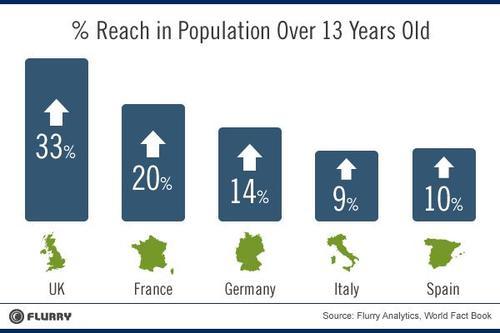
After having established the percent of each country’s monthly population that can be reached through smartphone apps, we next look at the pace of smartphone adoption, by country.
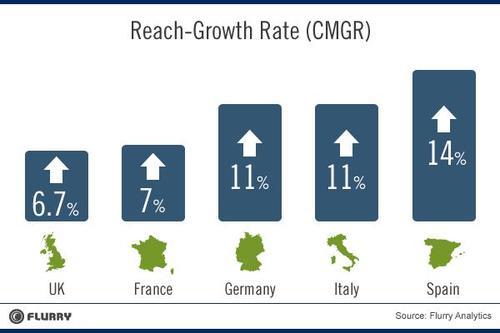
With growing adoption of iOS and Android-based smartphones, the imminent release of Nokia phones based on Windows Phone 7, and the fact that the majority of consumers actively use applications, we predict that the growth of this mass market media channel will continue to grow until near total smartphone market saturation. To underscore just how aggressively this channel is growing, if we assumed the growth of smartphone adoption continued at their current rates, all five countries would have full smartphone penetration in just over two years.
Games and Social Networking Rule
Flurry tracks the total number of application use sessions, from when consumers start app sessions to when they end them, and groups these sessions into categories such as games, news and travel. The top categories ranked by session usage worldwide are: Games, Social Networking, Sports & Entertainment and News.
The graph below shows how consumer usage varies by app category across the top five European markets.
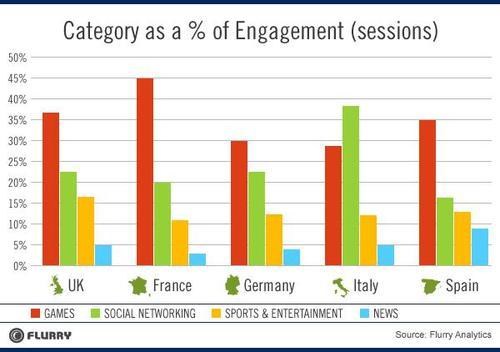
With the exception of Italy, the games category is the most popular app category across all countries. In Italy, the one country where the games category does not lead, Social Networking is the top category, with 38% of Italians using Social Networking apps compared to other categories.
Comparing each country’s proportion of usage by category, more consumers play games in France than compared to other countries – a massive 45% of all French app sessions are Games. In Spain, a greater percentage of the Spanish population consumes news compared to other countries, and the UK leads in relative Sports & Entertainment app consumption. In all 5 countries, the 4 top categories make up 80% of all traffic.
Solid App Retention and Engagement
In May 2011, the average worldwide 6-month retention rate for all apps was 36%. In other words, of all consumers who downloaded an app over the last six months ago, 36% had used that same app within the last 7 days of May (Flurry looks at “last 7 days” for its retention metric).
Continuing to look at the top 5 European countries, all have posted 6-month retention rates of greater than 30%. The chart below breaks out each countries 6-month retention rate compared to the worldwide average.
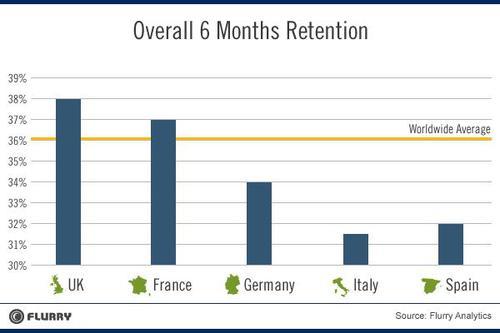
Reviewing the chart, we note that the UK leads in retention with 38%, followed by France at 37%, Germany at 34% and then Spain and Italy at 32% and 31.5%, respectively. Generally, we see a correlation between the maturity of a given market and app retention. We observe that consumers typically try several apps before they settle into using a group of favorites, which they then use several times per week, even per day. In less developed countries, we often see much more app experimentation. The five countries we review for this report are clearly all highly developed economies.
As a mass market media channel, smartphone apps not only reach a sizable audience today, but also continue to grow at staggering rates. The channel is already formidable with no signs of slowing. Smartphone app consumers are highly engaged and consider their smartphone among their most important personal possessions; we believe the 8th mass market media channel has indeed arrived in Europe.